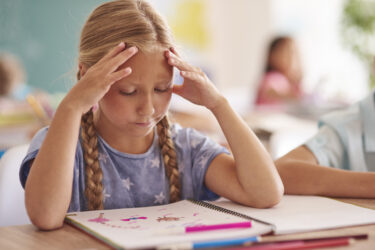Your child has great vision, right? It’s been a few years since his last eye exam though, and, what’s that? Is he squinting? Before you know it, you’re deciding on what color glasses to buy. What happened?
Most of the time, kids don’t really show the signs of needing glasses until they’re school-aged, says Michael B. Yang, M.D., a pediatric ophthalmologist.
“Nearsightedness (myopia or blurry distance vision) often develops over time,” Yang says, “and approximately four percent of children under the age of 6 have myopia with the incidence increasing to nine percent in older children,” he adds.
As long as kids get vision screenings often it’s likely that eye issues will be detected. But it’s important that your child gets examined annually by their pediatrician — symptoms or not — starting at 6 months old. The earlier problems are detected, the easier to correct them.
YOUR CHILD’S EYES AT BIRTH
Why do parents sometimes miss their child’s need for glasses? We know that babies don’t track well from birth, but often we don’t know what to look for when they’re toddlers.
“Usually, a pediatrician or neonatologist checks the newborn to make sure there are no signs of infection (redness or discharge), cataracts (cloudy lens), glaucoma (high eye pressures that may result in enlarged eyeballs or damaged optic nerves),” says Sarah L. Lopper, O.D., a pediatric optometrist at Cincinnati Children’s Hospital Medical Center.
If your doctor sees your baby’s eyes are normal, they will continue to screen him during well child visits for the first year. Many doctors continue screening children annually at their well-child check ups as they grow.
There are also programs — such as Cincinnati Children’s Hospital’s Vision Screening Program — that focus on treating reversible vision loss in children. In addition, trained program volunteers visit Greater Cincinnati and Northern Kentucky schools, health fairs and more to conduct screenings. “Infantsee,” a public health program managed by Optometry Cares, does vision screenings for free. Go to infantsee.org to find a location near you.
LOOKOUT FOR THE SIGNS
The most common problem when it comes to a child’s eyesight, is nearsightedness, and it requires glasses to correct it. If your child is squinting or struggling to read the letters in a book or a board, it may be time to agree on a shiny new pair of lenses.
According to both Yang and Lopper, other problematic signs to look out for include crossed or turned out eyes, a droopy eyelid, red eye(s) and an eye with a discolored or abnormal pupil. Pupils should be round and black, but if abnormal, could be white or other colors; or not round in shape. Call your doctor if you notice any of these issues.
PROTECT HIS VISION
Here are more ways to help protect your child’s eyes from problems or injuries.
AVOID RISKY ACTIVITIES
Using paintball and BB guns without the proper eye protection can cause serious injury. Make sure there is adult supervision and they are at the appropriate age for the activity.
TAKE OUT CONTACTS
It’s important for you to help your kids clean and replace lenses (as recommended) before bedtime. Sleeping with contacts can increase the risk of infection and even loss of vision.
WEAR SUNGLASSES
Kid’s eyes are at higher risk to sunlight and harmful UV rays. Babiators.com has affordable sunglasses, and will replace them for free if broken or lost.
MINIMIZE SCREEN TIME
Too much screen time at young ages can result in vision issues in kids, earlier. Get out the books and read instead.





